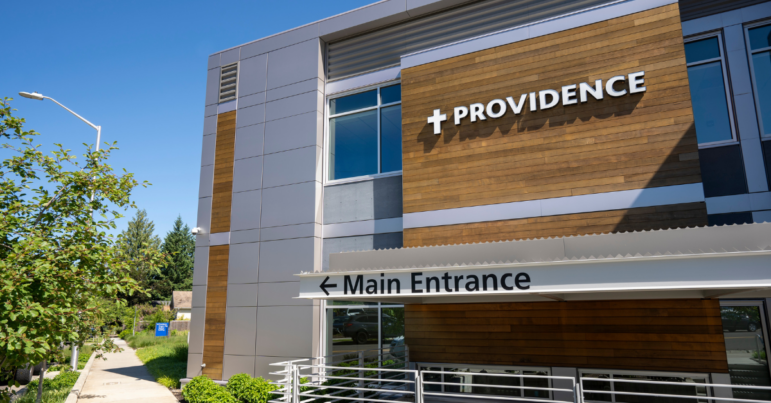Through our work with the Lown Institute Hospitals Index, we’ve seen how socially responsible hospitals can be. These top hospitals prioritize equity, while maintaining excellent patient outcomes and avoiding overuse.
But not all hospitals have performed well on social responsibility. In fact, the New York Times recently highlighted two nonprofit hospital systems that have gone against their social mission and put profits over patients. The Lown Institute’s research on fair share spending was featured in these articles. Here’s a breakdown of what the Times uncovered:
“They Were Entitled to Free Care. Hospitals Hounded Them to Pay”: Providence Health
Nonprofit hospitals are required to provide financial assistance (free and discounted care) as a condition of being a nonprofit. But in most states, there aren’t any requirements for how much assistance hospitals have to provide, leading many hospitals to spend as little as possible.
In fact, a Lown Institute report finds that most nonprofit systems spend less on charity care and programs to improve community health than the amount they receive in tax breaks — what we call a “fair share deficit.” At the top of the list of hospital systems with the largest fair share deficit is Providence Health System, based in Washington state, which underspent on community benefit by a whopping $705 million in 2019.
Now, an investigation from the New York Times provides some clues as to why Providence has such as large deficit. It has to do with the system’s “Rev-Up” program, created by Providence executives in collaboration with consulting firm McKinsey & Company in 2018. This program was designed specifically to squeeze as much money out patients as possible – regardless of if the patient qualified for free care. In Washington, where Providence is based, nonprofit hospitals are required by law to provide charity care to eligible individuals. If they could not pay, debt collectors were called in.
Providence financially ruined patients who were, by law, supposed to be eligible for free or discounted care. It simultaneously stripped its hospitals for parts in a business model designed to maximize revenue. This model differs drastically from the intended purpose of Providence, which was founded by nuns to give care specifically to the poor and vulnerable.
“How a Hospital Chain Used a Poor Neighborhood to Turn Huge Profits” – Bon Secours Mercy Health
Across the country, in Richmond, Virginia, another nonprofit hospital system was engaging in profiteering behavior. Bon Secours Mercy Health made over $1 billion in profits last year, and yet it was closing down critical service lines for Richmond Community Hospital, which serves a predominantly Black community.Bon Secours promised the physicians, staff, and community of Richmond Community Hospital that closed care units wouldn’t impact their care – they could always go to the next nearby hospital for care. This was over-promised. Patients in need of immediate, intensive care were left to wait for hours, deteriorating in front of the eyes of the staff who so desperately wanted to help them but had to wait for the patient to be transferred to a hospital that had the capacity to treat them. The sister of one patient who died in part to delayed care was devastated, saying, “He should have been able to go to the hospital and get the treatment he needed. He should have been saved.”
At the same time that Bon Secours was shutting down essential services at Richmond Community Hospital, they were making millions from its status as a safety net. BecauseRichmond Community Hospital is in a majority Black, majority working-class area, it qualifies for the federal 340B program, which allows safety net hospitals to purchase prescription drugs at a significant discount. They still charge insurers the same rate, and they don’t have to report the difference between the two values, allowing them to pocket any profits made from this program. Therein lies the value of Richmond Community Hospital to Bon Secours.
“Bon Secours was basically laundering money through this poor hospital to its wealthy outposts. It was all about profits.”
– Dr. Lucas English to the NY Times. Dr. English worked in Richmond Community’s emergency department until 2018.
The Times also reports that Bon Secours has opened nine satellite clinics that are legally subsidiaries of the hospital despite miles of distance between them. This allows those clinics to also utilize the 340B program and bring in more profits, all while the conditions at Richmond Community Hospital deteriorated to the point of staff describing their work as “disaster medicine.”
A different way is possible
The issue of nonprofit systems skirting their social responsibility is gaining awareness, especially amongst concerned state and local legislators. From Montana state Sen. Bob Keenan to North Carolina State Treasurer Dale Folwell to Washington state Sen. Patty Murray, legislators from coast-to-coast are questioning whether their statesmen could have better care and quality of life by reclaiming those lost tax dollars and using them for something else.
“The hospitals are sort of the pillars of communities, but people are starting to ask these questions.”
– Lown President Dr. Vikas Saini to NPR
Despite these stories, not every nonprofit hospital system is failing to live up to standards. Our findings show that some nonprofit hospital systems actually provide a surplus of benefits back to their communities, proving that it is possible to do things differently. The hospital system with the largest surplus, Memorial Hermann Healthcare System in Houston, TX, spent $147 million more on charity care and community investment than its tax breaks.
We all know that our healthcare system is broken, and this recent coverage emphasizes just how much is at stake for the people relying on hospitals in their most vulnerable times. The national fair share spending deficit is most certainly concerning, as are the practices of profit-seeking multi-billion dollar tax-exempt corporations. But those systems with a fair share spending surplus provide hope and a better way forward. We’re proud to be driving this movement and are grateful for the momentum it’s gaining.
